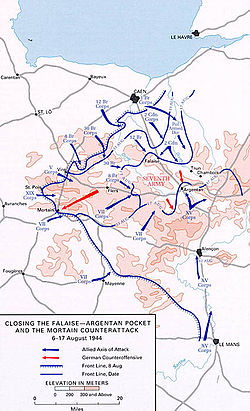

A counterattack is a tactic employed in response to an attack, with the term originating in "war games". [1] The general objective is to negate or thwart the advantage gained by the enemy during attack, while the specific objectives typically seek to regain lost ground or destroy the attacking enemy (this may take the form of an opposing sports team or military units). [1] [2] [3]
Contents
- Analyzing historical counterattacks
- Operation Bagration
- Battle of Austerlitz
- Battle of St. Vith
- See also
- Notes and references
- Bibliography
- Further reading
A counter-offensive is a broad-scale counterattack. The counter-offensive is executed after exhausting the enemy's frontline troops and after the enemy reserves had been committed to combat and proven incapable of breaching defenses, but before the enemy has had the opportunity to assume new defensive positions. Sometimes the counter-offensive can be of a more limited operational maneuver nature, with more limited objectives rather than those seeking attainment of a strategic goal. A counter-offensive was considered by Clausewitz to be the most efficient means of forcing the attacker to abandon offensive plans. [4] Counter-offensives can be executed not only on land, but also by the naval, and air forces. [5] Strategic counter-offensives have been recorded by military historians in many wars throughout military history. Although not always known as such, because they are usually described by historians in conjunction with the defensive phase, such as the Battle of Moscow.
A saying, attributed to Napoleon Bonaparte illustrates the tactical importance of the counterattack : "the greatest danger occurs at the moment of victory". In the same spirit, in his Battle Studies, Ardant du Pic noticed that "he, general or mere captain, who employs every one in the storming of a position can be sure of seeing it retaken by an organised counter-attack of four men and a corporal". [6]
A counterattack is a military tactic that occurs when one side successfully fends off the enemy’s attack and begins to push the enemy back with an attack of its own. In order to perform a successful counterattack, the defending side must quickly and decisively strike the enemy after defending, with the objective of shocking and overwhelming the enemy. [7] The main concept of the counterattack is to catch the enemy by surprise. [7] Many historical counterattacks were successful because the enemy was off guard and not expecting the counterattack. [7]

